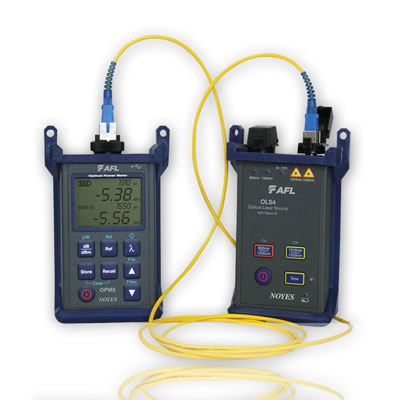The use of robotic vision delivers precision in production.
Discovering the Advantages of Optical Fiber Evaluating for Enhanced Interaction Systems
The value of optical fibre testing in contemporary communication systems can not be overemphasized, as it offers as a structure for making sure network dependability and efficiency. This proactive testing strategy has profound ramifications for signal top quality and operational performance, raising the concern of just how these methods add to long-lasting sustainability in an ever-evolving technological landscape.
Significance of Optical Fiber Testing
The relevance of optical fiber testing can not be overemphasized in today's data-driven atmosphere. As organizations progressively rely upon high-speed information transmission for daily procedures, the integrity and performance of optical fibre networks are critical. Checking ensures that these networks can support the huge amounts of data generated and transmitted seamlessly, cultivating reliable interaction and connection.
Optical fibre testing offers several vital functions, including verifying installation top quality, recognizing prospective mistakes, and determining total system efficiency. Regular screening can avoid costly downtimes and service disruptions, permitting organizations to maintain operational continuity. It assists in compliance with industry criteria and guidelines, making sure that fiber optic installments satisfy needed requirements for security and integrity.
Furthermore, screening can improve the durability of fiber optic systems. By proactively identifying issues such as signal loss, attenuation, or connector failures, companies can resolve troubles prior to they intensify, thus expanding the life of their framework. In summary, optical fiber screening is not merely a technological demand yet a critical financial investment that improves network dependability, enhances efficiency, and eventually sustains the growth and performance of modern interaction systems.
Key Evaluating Methods

OTDR is a vital strategy made use of to recognize mistakes, action splice losses, and examine the overall stability of a fibre optic web link. By sending out a pulse of light down the fibre and assessing the reflected light, specialists can determine locations of mistakes and assess the network's efficiency over fars away.
Insertion loss screening measures the amount of signal loss that takes place when light passes with a connection or splice. This technique is essential for verifying that links meet given loss limits, which is important for maintaining optimal performance in communication systems.
Optical return loss screening evaluates the quantity of light showed back towards the source due to flaws in the fibre or links. High return loss worths indicate far better efficiency and decreased signal degradation.
Together, these testing techniques supply a thorough analysis of fibre optic networks, ensuring their reliability and performance in varied communication applications.
Impact on System Efficiency
Effective optical fiber testing straight affects the total efficiency of communication systems. By making sure the integrity of fibre optic cords, screening recognizes possible faults such as attenuation, splice loss, and adapter imbalance. These concerns can significantly weaken signal quality, resulting in interruptions and decreased data transmission rates.

In addition, regular optical fiber screening adds to lasting system sustainability. It makes it possible for very early detection of damage, allowing for timely upkeep and upgrades before major failures happen. This not just lengthens the lifespan of the facilities however also makes certain that communication systems continue to be competitive in terms of performance.
Cost-Effectiveness and Performance
Cost-effectiveness is a critical consideration in the implementation and upkeep of optical fibre networks. Implementing durable optical fiber screening procedures can substantially decrease operational costs by determining problems before they escalate into significant issues. robotic vision. By detecting mistakes, attenuation, and various other performance obstacles early, organizations can stay clear of published here pricey repair services and downtime, which can interrupt services and bring about income loss
In addition, efficient screening methodologies simplify the installation process, enabling specialists to function better. This translates to lower labour visit this page costs and faster job conclusion times. Advanced screening devices, such as Optical Time Domain Name Reflectometers (OTDRs), makes it possible for an accurate evaluation of fibre quality, making certain that just ideal materials are utilized, therefore decreasing waste.
Normal screening likewise adds to better resource allocation. By recognizing the network's performance, organizations can make enlightened choices regarding upgrades and developments, guaranteeing that investments are made where they are most needed. In recap, optical fibre testing boosts cost-effectiveness and effectiveness, supporting the long-lasting sustainability and competition of interaction systems in a significantly requiring market.
Making Certain Long-Term Dependability
Carrying out extensive optical fiber screening not only enhances price financial savings and operational effectiveness yet additionally plays a critical role in making certain the long-lasting reliability of communication networks. Regular screening techniques, including depletion and bandwidth evaluations, aid identify possible destruction in fibre efficiency prior to it results in service disturbances.
By using advanced screening methodologies, network operators can see this website identify faults or weaknesses in the fiber facilities, permitting timely remediation. This aggressive method decreases downtime, ensuring that communication systems continue to be functional and reliable. Additionally, normal testing adds to the advancement of a more durable network, as operators can adapt and maximize their facilities based upon real-time data insights. fibre testing equipment.
Additionally, making sure conformity with industry requirements with optical fiber screening reinforces the high quality and integrity of the entire communication system. This adherence not just strengthens self-confidence amongst stakeholders but additionally aligns with regulative requirements, which are increasingly rigorous.
Verdict
In final thought, optical fiber testing works as an essential component in improving interaction systems. By employing various testing approaches, such as OTDR and insertion loss assessments, networks can achieve optimal efficiency and reliability. The positive recognition of faults not only improves signal quality however additionally lowers downtime, eventually adding to cost-effectiveness and functional performance. Adherence to market standards promotes stakeholder confidence, making certain the long-lasting sustainability of communication facilities in a significantly data-driven landscape.